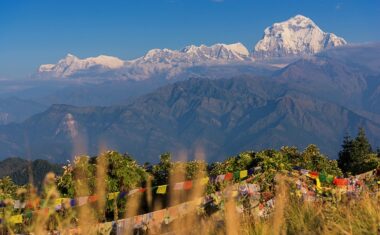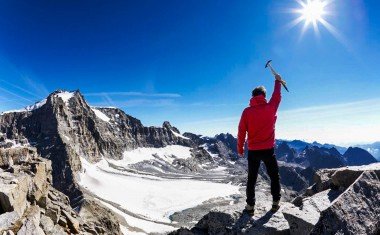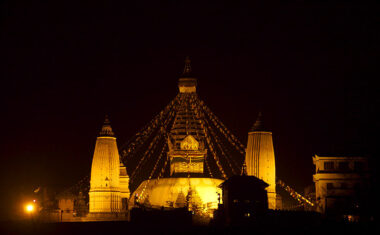Paragliding in Nepal

-
Overview
- Destination: Nepal
- Activities: Adventure Activities in Nepal
PARAGLIDING IN NEPAL- POKHARA
Soaring through the air and careening through the fluffy cloud layers, like a carefree bird, paragliding is probably Men’s closest chance to experience the sensation of free flight in the air. It is flying in a pure form, very much like how birds fly, due to changing air pressure, to keep them aloft. The joy of paragliding is having that feeling of being way up high without the aid of any engines, in a natural way, with all control over you. Aircraft employ engines and need runways, while paragliding, depending on your expertise, can land in almost any clearing.
Paragliding in Nepal is a fairly recent addition to the increasing number of adventure sport choices in Nepal. With the revival of tourism in Nepal, the activity has picked up its pace, especially in Pokhara. On sunny days, looking northwest-wards from Lakeside, brightly colored specks can be seen floating about in the pristine sky, hilarious view of Mountain. You can also experience unparalleled scenic grandeur as you share airspace with Himalayan griffin vultures, eagles, and kites while floating over villages, monasteries, temples, lakes, and jungles, all with a fantastic view of the majestic Himalayas.In Nepal, there are also varied versions of paragliding to inject renewed interest to enthusiasts. There is para trekking in which fliers will soar cross-country, for about one week, stopping in villages along the way to rest. The next morning Para trekkers will head towards a higher position and catch the thermals to soar once again. There are such routes flying from Tansen in Palpa District, ending in Pokhara. There is also parahawking where experienced pilots will work together with trained falcons to catch the best thermals and soar like the birds of prey.
The hot spot for paragliding in Nepal is the Pokhara valley. At 800 meters above sea level, the mild climate makes it an ideal area for flying, far more stable than the Kathmandu valley. There are several launching sites around the tourist area of Lakeside. The popular one is Sarangkot which has a road leading to the top. There is a dedicated takeoff area especially cleared for paragliding. Almost all companies of paragliding in Nepal and commercial pilots are based in Pokhara for the flying season from October to March, with the best months being November and December. As flying is dependent on thermals and ridge winds, this activity is highly dependent on the weather. The best times to glide during the day is between 9 and 11 o’clock in the morning. The best thermals form when the ground is just starting to heat the air.
paragliding in Nepal is becoming extreme popular among the tourist so the other region of Nepal is also trying to start paragliding in nepal.
A flight takes about ½ to ¾ hour, depending on the thermals, when taking off from Sarangkot. Commercial trips, which can be booked from Lakeside, include a ride from Lakeside to the summit of Sarangkot. After the flight, the vehicle will send you back into town from the landing site at the far western edge of the lake. Do bring along a windproof jacket and wear shoes for the flight. Its quite rude to send slippers or sandals falling down from the sky. Flying in the skies is quite safe and even acrophobic can consider the activity – just keep your eyes on the picturesque scenery of the Annapurna massifs towering high over the northern skyline.
History of PARAGLIDING.
During the ‘space race’ between the Soviet Union and United States in the 1960s, an American aeronautical engineer crafted a parachute to aid the landing of returning spacecraft. With a stroke of ingenuity, and excited by the possibilities of this parachute’s usage for civilian purposes, he tweaked the prototype design. In September 1965, at New York’s Belleayre Ski Resort, David Barish became the ‘Father of Paragliding’ as he took into the skies with his new contraption. To the untrained eye and viewed from afar, a paraglider’s canopy looks suspiciously like that of a parachute, as used in sky diving. Yet their purposes differ greatly.
A paraglider’s design dynamics are more like that of the wings of an aircraft rather than rounded shape of a parachute. When the glider’s wing is inflated with air, it forms a teardrop aero foil shape, just like an aircraft wing. The main purpose of a parachute is to slow down descent, while a paraglider launches its flier higher into the air and enables further and longer travel.
Some have drawn parallels between paragliding and hang-gliding. Both glide in the air, harnessing the outthrust of thermals and winds. But the major difference is its structural design. Hang-gliders have a sturdy metallic frame forming a spearhead shape, whereas paragliders have no hard interior frame. Due to design differences, paragliders have lower flying speeds, but afford more control even in less favorable wind conditions.How to FLY.
Paragliding requires a running start to take off; one cannot simply jump off a cliff as this is not parachuting. Observing the wind direction, an experienced pilot will walk into a gusty breeze to aid lifting the canopy. When one runs, the glider catches wind and chambers in the canopy fill up with air. This running start is done in a downhill direction. If one runs uphill, it is very tough for the glider to run fast and far enough for the chambers to fill with air. Once a strong wind is caught, the canopy fills and lifts, the pilot (and his passenger if in tandem flight) who is still running will feel being lifted off the ground. With hands on the guiding strings, the pilot can steer the direction, twisting, tugging and turning his or her body in the required direction.
What Happens When it FLY.
A common complaint by first-time fliers is that paragliding can be quite a nauseating adventure. This problem arises in certain situations. One is when the glider starts to spiral or spin when the canopy is caught in forceful thermals and winds. This fortunately does not happen regularly for first-timers flying tandem with commercial operators, as the experienced pilots choose familiar and safe ‘air-routes’ to fly. It is usually towards the end, as the pilot carefully maneuvers the glider for landing that a giddy feeling sets in. The pilot has to fly in a tightening circular path as its path spirals to that exact landing point.



